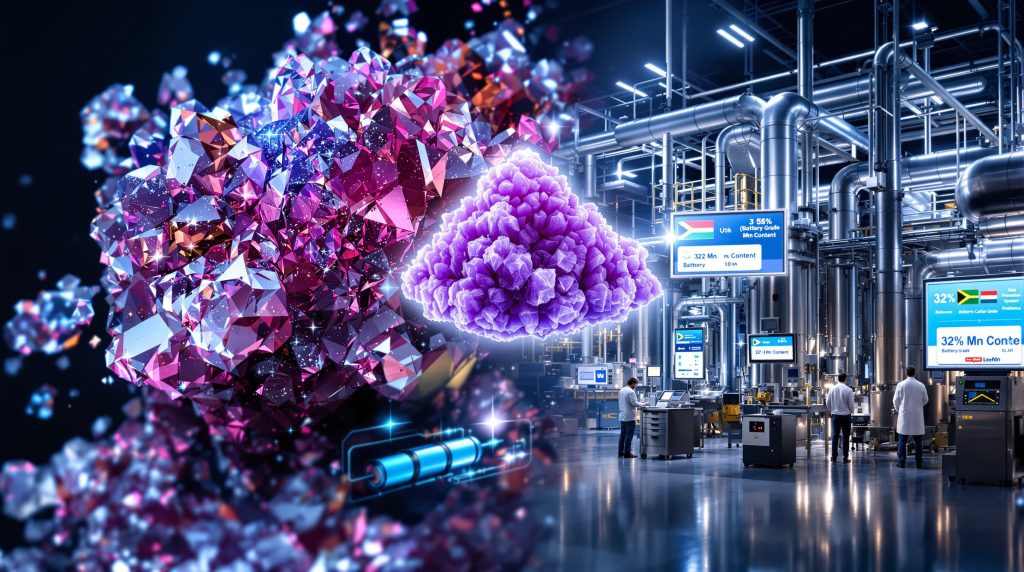Manganese Beneficiation: Johannesburg Demo Plant Success and Future Implications
Manganese beneficiation represents a critical process in transforming raw manganese ore into high-value products for the growing battery industry. The recent success at the Johannesburg demonstration plant marks a significant milestone in developing regional battery material capabilities in Southern Africa, with far-reaching implications for the global battery metals investment supply chain.
What is Manganese Beneficiation and Why is it Important?
Manganese beneficiation involves processing raw manganese ore into higher-value products through various metallurgical techniques. This process elevates the material from basic commodity status to specialized battery-grade inputs, creating substantial economic value.
The global manganese market, valued at approximately USD 20.8 billion in 2023, is projected to reach USD 29.5 billion by 2030, growing at a CAGR of 5.1%, according to Grand View Research's 2024 analysis. This growth is largely driven by increased demand for battery applications.
For resource-rich nations, manganese beneficiation offers multiple strategic advantages:
- Transforms low-value raw ore into high-value battery-grade materials
- Enables participation in the lucrative electric vehicle supply chain
- Creates significant economic value beyond mere resource extraction
- Supports energy transition technologies through battery metal production
- Reduces dependency on international processing facilities
The value differential between raw manganese ore (typically 30-48% Mn) and battery-grade manganese sulfate monohydrate can be 10-15 times higher on a per-tonne basis, according to the International Manganese Institute's 2024 report on battery applications.
According to Benchmark Mineral Intelligence, high-purity manganese sulfate demand for batteries is expected to grow from approximately 200,000 tonnes in 2023 to over 1.2 million tonnes by 2030, underscoring the strategic importance of developing regional processing capabilities.
South Africa's position is particularly significant, holding approximately 74% of the world's identified manganese resources with over 6.1 billion tonnes of reserves, predominantly in the Kalahari Basin which extends into Botswana, according to the United States Geological Survey's 2024 Mineral Commodity Summary. These abundant resources provide tremendous South Africa beneficiation opportunities across the mineral processing value chain.
How Does the Johannesburg Demo Plant Fit into Global Manganese Processing?
The Johannesburg demonstration plant represents a critical counterbalance to China's dominance in the high-purity manganese sulfate production sector, which currently accounts for 85-90% of global capacity according to Roskill Information Services' 2024 market analysis.
Strategic Location and Purpose
Located in South Africa's economic hub, the facility serves as a proving ground for innovative hydrometallurgical processes before full-scale commercial implementation. This strategic positioning allows direct access to South Africa's vast manganese resources, which produce over 7 million tonnes of manganese ore annually but historically export most as raw material or ferroalloy rather than battery-grade products.
Technological Innovation Focus
The plant employs cutting-edge processing techniques that deliver significant environmental and efficiency improvements:
- Validates novel hydrometallurgical processes requiring 30-40% less energy compared to traditional pyrometallurgical methods
- Optimizes production parameters for consistent quality
- Reduces environmental impacts through improved recovery rates
- Tests various ore compositions from regional deposits
- Establishes quality control protocols for battery-grade outputs
Bridge to Commercial Production
As a demonstration facility, the plant bridges the gap between laboratory research and full commercial implementation. According to industry standards documented by the Society for Mining, Metallurgy & Exploration, demonstration plants in mineral processing typically operate at 1-5% of full commercial scale, processing between 100-500 tonnes per year of feed material.
This intermediate step is crucial for reducing technical risk. Studies by Independent Project Analysis Inc. show that demonstration plants typically reduce capital cost estimation uncertainty from ±40% to ±15% and improve operating cost projections accuracy from ±35% to ±20%.
What Products Has the Demo Plant Successfully Produced?
The Johannesburg demonstration plant has achieved significant production milestones with two key battery-grade manganese products.
High Purity Manganese Sulphate Monohydrate (HPMSM)
The facility has successfully produced HPMSM that meets stringent battery industry requirements:
| Parameter | Achieved Specification | Industry Requirement |
|---|---|---|
| Mn Content | >32% | >31.5% |
| Heavy Metal Impurities | <100 ppm combined | <100 ppm combined |
| Moisture Content | Controlled (13-15%) | Standardized |
| Particle Size | Uniform distribution (D50: 20-100 microns) | Application-specific |
According to Battery Council International's 2023 technical specifications, battery-grade HPMSM requires manganese content of 31.5-32.5%, with combined heavy metals below 100 ppm, making the demonstration plant's achievement significant for market acceptance.
HPMSM serves as a critical precursor material in lithium-ion battery cathode production, particularly for NMC (Nickel-Manganese-Cobalt) chemistries widely used in electric vehicles. Each electric vehicle battery pack typically contains 4-5 kg of manganese when using NMC cathodes, according to the International Manganese Institute.
Major cathode manufacturers including Umicore (Belgium), BASF (Germany), and several Chinese producers use HPMSM as feedstock for producing NMC 622 and NMC 811 cathode precursors, as noted in The Faraday Institution's 2023 research report.
High Purity Manganese Oxide (HPMO)
Earlier in 2025, the plant demonstrated successful production of HPMO, offering:
- Alternative battery chemistry applications for LMO (lithium manganese oxide) batteries
- Diversified product portfolio beyond HPMSM
- Flexibility to serve multiple market segments
- Adaptation to evolving battery technology requirements
The price differential between these refined products and raw materials is substantial. Battery-grade manganese sulfate typically trades at $2,000-3,500/tonne versus manganese ore at $150-250/tonne, according to Fastmarkets' Q3 2024 Manganese Price Assessment.
What Technical Processes Are Used in the Demo Plant?
The Johannesburg demonstration plant employs sophisticated hydrometallurgical processes that represent significant advances over traditional methods.
Innovative Hydrometallurgical Flowsheet
The facility utilizes a multi-stage process with impressive performance metrics:
- Ore Preparation: Crushing, grinding, and physical separation to prepare the feed material
- Leaching: Selective dissolution of manganese using optimized acid solutions
- Purification: Removal of impurities through precipitation and filtration
- Crystallization: Formation of high-purity manganese compounds at controlled temperatures (40-60°C)
- Drying and Packaging: Final product preparation meeting strict quality standards
The primary reaction in the sulfuric acid leaching stage involves:
MnO₂ + H₂SO₄ + reducing agent → MnSO₄ + H₂O + oxidized products
This process operates at temperatures between 60-95°C under atmospheric pressure with 2-4 hours residence time, according to Minerals Engineering's 2022 publication on reductive leaching of manganese ores.
Process Optimization Achievements
Through continuous operation, the plant has achieved several technical milestones:
- Manganese extraction efficiency of 92-98%
- Product purity exceeding 99.9%
- Water recycling rates of 85-95%
- Reduced reagent consumption compared to conventional methods
- Optimized energy efficiency across process stages
- Minimized waste generation through improved recovery rates
- Enhanced product consistency through automated control systems
- Validated scalability for commercial implementation
The purification stage employs multiple techniques including:
- Iron removal via oxidative precipitation (pH 3-4)
- Heavy metal removal via sulfide precipitation
- Calcium/Magnesium removal via selective precipitation
- Final polishing through ion exchange or solvent extraction
According to research published in Hydrometallurgy (2023), these optimized flowsheets can reduce acid consumption by 20-30% compared to conventional processes through improved leaching kinetics and reagent recycling systems.
How Will the Demo Plant Inform Future Commercial Operations?
The demonstration plant provides crucial operational data that directly influences the design and implementation of the planned full-scale facility.
Derisked Process Flowsheet
The data generated will inform multiple aspects of the commercial plant design:
- Validated equipment selection and sizing parameters
- Confirmed reagent consumption rates and specifications
- Established control system requirements and setpoints
- Identified potential operational bottlenecks and solutions
- Quantified environmental performance metrics
From the Mining Weekly report (October 2025), Giyani Metals' interim executive chairperson Nigel Robinson emphasized that "The demo plant has been invaluable in informing the new optimised process flowsheet" that will be carried forward to the K.Hill project.
Quality Assurance Framework
The demonstration has established quality control protocols that will transfer to commercial operations:
- Sampling methodologies for consistent product evaluation
- Testing procedures aligned with customer requirements
- Documentation standards for quality certification
- Traceability systems for production batches
- Continuous improvement frameworks
This quality focus is essential for market acceptance. According to industry best practices documented by the Society for Mining, Metallurgy & Exploration, pilot/demonstration plants reduce the likelihood of cost overruns during full-scale implementation by providing actual operational data rather than relying solely on laboratory or computational models.
What is the K.Hill Project and How Does it Connect to the Demo Plant?
The K.Hill project represents the commercial implementation of the technology validated at the Johannesburg demonstration plant, with significant regional importance.
Project Overview
Located approximately 60 kilometers southwest of Gaborone, Botswana, K.Hill will utilize the optimized flowsheet developed through the demonstration plant operations. This location places it strategically within the Kalahari Manganese Basin, which hosts one of the world's largest manganese deposits.
The Kalahari Manganese Field in neighboring South Africa has been producing since the 1940s and contains resources exceeding 4 billion tonnes, according to the Council for Geoscience South Africa's 2022 report.
Development Timeline
The project is progressing through several key milestones:
- Q1 2026: Targeted completion of definitive feasibility study to NI 43-101 standards
- 2026-2027: Projected construction phase (subject to final investment decision)
- 2028: Anticipated commercial production commencement
The NI 43-101 standard requires comprehensive documentation including:
- Independent qualified person oversight
- Detailed geological resource estimation
- Comprehensive metallurgical testing
- Environmental impact assessment
- Economic analysis including sensitivity studies
- Risk assessment and mitigation strategies
Production Capacity
The planned commercial facility will feature:
- 80,000 tonnes per year HPMSM production capacity
- Potential for HPMO production line based on market demand
- Supporting infrastructure for sustainable operations
This scale of production would represent a significant addition to global battery-grade manganese supply outside of China, which currently dominates the market.
What Financial Support Has Been Secured for the Project?
The K.Hill project has secured substantial financial backing from multiple sources, highlighting growing recognition of battery manganese's strategic importance.
Current Funding
According to the Mining Weekly report, the project has secured significant financial backing:
- R10 million from private equity fund ARCH Sustainable Resources (approximately $0.58 million at October 2025 exchange rates)
- $16 million convertible loan facility from South Africa's Industrial Development Corporation (IDC)
- Combined $26.58 million for progression toward final investment decision
The Industrial Development Corporation of South Africa is a state-owned development finance institution that specifically targets strategic sectors including beneficiation and renewable energy technologies. The IDC's 2024 Strategic Plan emphasizes support for projects that create jobs and add value to South Africa's mineral resources through beneficiation.
Potential Future Financing
Additional financing options are being explored:
- Letter of intent from Export-Import Bank of the United States for up to $225 million in long-term debt
- Potential 15-year repayment terms for construction financing
- Additional equity partners for project development
The Export-Import Bank of the United States provides financing support for projects that involve procurement of US equipment and services. Under the EXIM "Make More in America" initiative, the bank has prioritized critical minerals energy security supply chains, including battery materials.
Industry benchmarks from Wood Mackenzie's 2024 Battery Materials Capital Cost Benchmarking suggest total capital requirements of $300-400 million for HPMSM facilities of similar scale, contextualizing the $225 million potential financing amount.
What Markets Will the Commercial Project Serve?
The K.Hill project aims to supply multiple segments within the rapidly growing battery materials market.
Primary Battery Markets
According to the International Energy Agency's Global EV Outlook 2024, electric vehicle sales reached 13.6 million units in 2023 (16% of total vehicle sales) and are projected to reach 30 million units annually by 2030. This growth drives demand for battery materials like manganese.
The project will target:
- Electric vehicle battery manufacturers using NMC chemistries
- Energy storage system producers for grid applications
- Consumer electronics battery makers
- Power grid stabilization technologies
- Uninterruptible power supply systems
Global battery energy storage capacity additions reached 45 GW in 2023 and are projected to exceed 80 GW annually by 2028, according to IHS Markit's Energy Storage Market Tracker (Q4 2023).
Secondary Agricultural Applications
Manganese byproducts from the operation may serve agricultural sectors:
- Fertilizer production utilizing manganese compounds
- Soil amendment products for manganese-deficient regions
- Animal feed supplements incorporating manganese nutrients
Geographic Market Reach
The project is strategically positioned to serve:
- African battery manufacturing initiatives in Egypt, Morocco, and South Africa
- European automotive supply chains seeking diversified material sources
- North American energy storage markets
- Global battery technology developers
Battery chemistry distribution currently shows NMC chemistries (containing manganese) representing approximately 60% of EV batteries globally, with LFP (lithium iron phosphate, no manganese) accounting for ~35% and other chemistries (including LMO with manganese) ~5%, according to BloombergNEF's Battery Metals Outlook 2024.
How Does This Project Impact Regional Development?
The K.Hill project offers significant regional development benefits beyond direct economic returns.
Economic Benefits
Botswana's mining sector already contributes approximately 25% of GDP, with the country ranking as the world's second-largest diamond producer. The K.Hill project represents important diversification into battery metals.
The project offers multiple economic advantages:
- Job creation throughout construction and operational phases
- Skills development in advanced metallurgical processes
- Technology transfer to the regional workforce
- Supply chain development for supporting industries
- Foreign direct investment attraction
Industrial Diversification
Beyond immediate economic impacts, the project contributes to:
- Reducing dependency on raw material exports
- Developing higher-value industrial capabilities
- Building technical expertise in battery material production
- Creating opportunities for downstream manufacturing
- Establishing regional centers of excellence in battery materials
This aligns with Botswana's national strategy of economic diversification beyond diamonds, as outlined in the country's Ministry of Minerals and Energy "National Minerals Policy" (2023).
What Environmental Considerations Apply to Manganese Beneficiation?
Modern manganese beneficiation emphasizes environmental responsibility through comprehensive management systems.
Sustainability Focus
The hydrometallurgical processes employed at the demonstration plant offer significant environmental advantages:
- Water recycling and conservation systems achieving 85-95% recycling rates
- Energy efficiency optimization requiring 30-40% less energy than pyrometallurgical alternatives
- Waste minimization and valorization through improved recovery rates
- Reduced carbon footprint compared to conventional processing
- Responsible reagent management with potential 20-30% reduction in consumption
These improvements address growing customer demands for sustainably produced battery materials with lower environmental footprints.
Environmental Management Systems
The demonstration plant has helped establish environmental protocols for:
- Emissions monitoring and control
- Wastewater treatment and recycling
- Solid waste management and potential reuse
- Noise and dust mitigation
- Site rehabilitation planning
These protocols will be scaled and implemented at the commercial facility, ensuring compliance with Botswana's environmental regulations and international best practices.
What Are the Future Prospects for Manganese in Battery Technologies?
Manganese's role in battery technologies continues to evolve, with several trends pointing to increased importance.
Evolving Battery Chemistries
According to the International Energy Agency's assessment, manganese is positioned as a "medium criticality" battery material, with growing importance as battery chemistries evolve toward higher manganese content to reduce cobalt dependency and improve cost-effectiveness.
Key trends include:
- Increasing manganese content in NMC cathodes (from NMC 111 to NMC 712)
- Development of high-manganese cathodes (up to 70% Mn content)
- Exploration of manganese-rich lithium-ion phosphate alternatives
- Research into sodium-ion batteries using manganese compounds
- Potential applications in solid-state battery technologies
Research published in Nature Materials (2023) highlights manganese-based cathode materials as crucial for sustainable lithium-ion batteries, particularly as the industry seeks to reduce dependency on cobalt and nickel.
Supply Chain Security
Battery-grade manganese is increasingly recognized as a strategic material:
- Growing concerns about supply chain concentration with China controlling 85-90% of production
- Efforts to diversify battery material sourcing across multiple regions
- Emphasis on ethical and sustainable production methods
- Development of regional processing capabilities
- Integration into critical mineral strategies by major economies
This security focus creates opportunities for new entrants like the K.Hill project to serve markets seeking supply diversification. Furthermore, the implementation of data-driven mining trends can optimize operations and enhance productivity within such facilities.
Conclusion: Significance of the Johannesburg Demo Plant Success
The successful production of battery-grade manganese products at the Johannesburg demonstration plant represents a significant milestone in developing regional battery material capabilities. By validating innovative processing technologies and establishing quality control frameworks, the project paves the way for commercial implementation at the K.Hill site in Botswana.
This development carries strategic importance beyond its immediate technical achievements, supporting regional industrial diversification, participation in global battery supply chains, and sustainable resource utilization. As mining industry innovation continues to evolve, the capabilities demonstrated at this facility position Southern Africa to capture greater value from its manganese resources while contributing to global energy transition efforts.
With HPMSM trading at $2,000-3,500/tonne versus manganese ore at $150-250/tonne, the economic value addition through beneficiation is substantial. This value capture, combined with the growing demand for battery materials as electric vehicle adoption accelerates, creates compelling opportunities for manganese-rich countries to develop downstream processing capabilities.
The demonstration plant's dual-product capability (HPMSM and HPMO) provides flexibility to serve evolving market requirements, strengthening the commercial prospects for the K.Hill project as it moves toward implementation.
Ready to Capture the Next Major Mineral Discovery?
Get real-time alerts on significant ASX mineral discoveries through Discovery Alert's proprietary Discovery IQ model, transforming complex geological data into actionable investment insights. Explore how historic discoveries have generated substantial returns by visiting the Discovery Alert discoveries page and start your 30-day free trial today.




